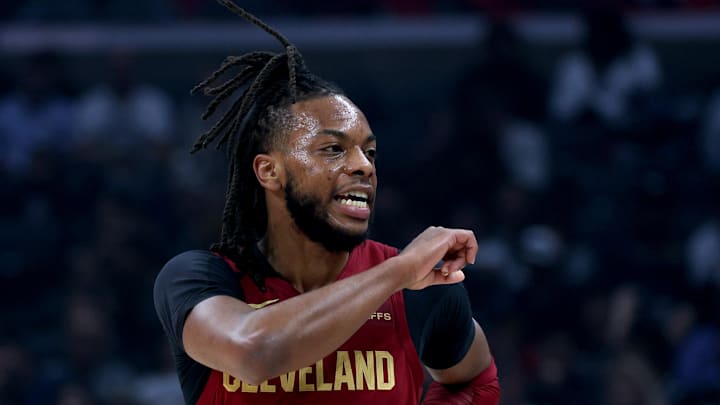The physically and mentally fragile Cleveland Cavaliers are on the verge of a collapse just before the playoffs and likely headed to a similar fate as last season.
Lingering issues with Donovan Mitchell’s knee and absences from others are the main culprit but save for a supernatural Finals trip, no one should believe this group can run it back. As talented as they are, they haven’t proven anything when it matters most, and the top priority should be enticing Mitchell to stay. Aside from moving Evan Mobley, all options should be on the table.
Major trades would have to yield substantial returns that complement Mitchell. The top trade chips are Darius Garland and Jarrett Allen but both pose a risk.
The case for Cleveland trading Darius Garland
The case for exchanging DG for supplemental pieces is that Mitchell had his best stretch of the season as the point guard, and the unit didn’t lose often while also being without Mobley for 18 games, too. In fact, during the 19 straight games Garland missed between Dec. 16 and Jan. 29, the Cavaliers went 15-4. Mitchell played in 15 outings; his averages were 28 points, 4.9 rebounds and 7.9 assists per game.
In this span, the Cavaliers had some top-shelf ball movement powering them to victories, and it had a top-two defense in January. The primary lineup for the time was Mitchell, Max Strus, Isaac Okoro, Dean Wade and Allen. Mitchell’s rim pressure and passing activated this group, and it was a more efficient rotation (EFG-58.2 percent) in comparison to the primary band- Garland, Mitchell, Strus, Mobley and Allen (EFG-57.2 percent). On top of that, the emergency lineup produced 3.3 percent fewer turnovers, per Cleaning the Glass (subscription required).
Since Garland’s return from a broken jaw, he has taken more long jumpers and is registering the second-lowest deep splits (36.8 percent) of his career.
The flaw in dealing DG is that unless Craig Porter Jr. goes from 13th man to somewhere in the top eight or a serviceable point guard comes back in a trade, this change could eat away at Mitchell’s legs sooner. To boot, Garland is a dynamic ball handler and takes 15.4 drives per game, good enough for ninth most in the league. Still, he doesn’t get to the rim as much as the Cavaliers need from him. He attempts only 17 percent of his shots within 0-3 feet. A lot of the time DG gets into the paint, he is setting up a teammate, which is still valuable.
The NBA defines drives as: “When a player attacks the basket off the dribble in the halfcourt offense. Does not include situations where the player starts close to the basket, catches on the move, or immediately gets cut off on the perimeter.”
Not having another shot creator except Caris LeVert on the bench will lower Mitchell’s ability to hunt for easier shots off the ball. Still, he will have the option if Allen and or Mobley are setting up dribble handoffs. And despite Strus’ continued development as a playmaker, he’s still best as a relocating sniper and cutter.
The case for the Cavaliers to keep Garland, deal Jarrett Allen
Allen is the Cavs’ best trade chip, and moving him can only be done if the Cavaliers believe that Mobley is ready to take over. Remember, despite the Cavaliers’ rough last 21 games, Allen has been Mr. Dependable and an All-Defensive Team candidate. Such abilities could command a nice return in a swap. Such a change would either promote Wade back to power forward, or whoever arrived in the deal would have to be a better-than-average 3-point marksman to take advantage of the extra attention Mobley will create in the paint.
Wing help would be ideal in a swap for Allen, but could the Cavaliers get away with it? Perhaps if they get back pieces that can cover Mobley’s weaknesses and/or make Mitchell’s life easier.
At the stage Mobley is developing, maybe he could expedite his growth with higher usage in Allen’s absence. Already, he is one of the top-cutting bigs in the NBA, which puts pressure on a defense with movement. Additionally, being the primary big man would give him more opportunities to be the secondary or third playmaker. This season, Evan is averaging a career-high in assists per game (3.2), with direct feeds and dribble handoffs. He’s lethal when faking the DHO and getting downhill, as well.
But with added responsibility, growing pains are common, especially for young big men because they don’t develop as quickly as guards and forwards.
Despite the disturbing loss on Sunday to the Clippers in Los Angeles, Mobley’s arsenal was popping early. He got things started, converting five of seven tries. First, he dove and caught a lob from Garland after the handoff, got loose off-ball for a dunk plus ran three pick-and-roll sets, resulting in floaters.
Yet, after Mobley dribbled into Zubac in transition and hooked and made two layups, he bricked his last five tries at close, medium and long-range, guarded by Mason Plumlee. Today, he is still far away from the finished product, and there is still much he could learn from a veteran like Allen, who has been more impactful in the present.
While president Koby Altman’s salary is enviable, the decisions he has to make are not. The Cleveland Cavaliers will have all eyes on them this summer with Mitchell's extension on the line and a talented yet redundant young core.
